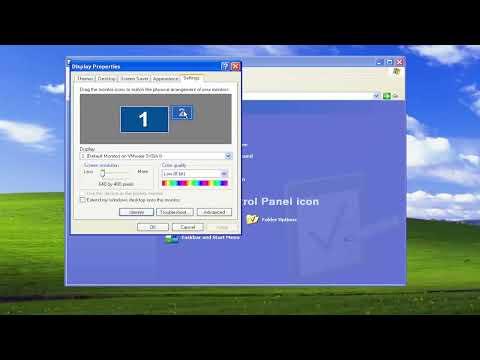I was always the kind of person who took great pride in keeping my computer running smoothly. I had my trusty Windows XP machine, which, despite its age, had served me well for years. But one day, I noticed that the display was looking a bit off. Everything seemed too stretched out, and text was less sharp than it used to be. My screen resolution had clearly changed, and I had no idea how to adjust it back to where it should be.
I decided it was time to tackle this problem head-on. I started by diving into the Control Panel, a place I had navigated countless times before, but I wasn’t entirely sure how to fix this particular issue. The first thing I did was click on “Start” and then “Control Panel.” From there, I was looking for the “Display” settings. In Windows XP, the path to adjusting your screen resolution is fairly straightforward, but if you’re not familiar with it, it can seem a bit labyrinthine.
Inside the Control Panel, I found the “Display” icon and clicked on it. This brought up the Display Properties window, which has multiple tabs. I clicked on the “Settings” tab, where the screen resolution settings are located. The resolution drop-down menu was exactly what I needed. The current resolution setting was displayed at the top, and there was a slider I could adjust. I saw that the resolution was set to a lower value than usual, which explained why everything looked so stretched.
I took a moment to recall the ideal resolution for my monitor. Fortunately, I remembered that my screen’s native resolution was 1280×1024. This was important because setting the resolution to anything other than the monitor’s native resolution would result in less sharp and clear images.
With this in mind, I selected 1280×1024 from the resolution list. The screen flickered for a moment as it adjusted to the new setting. I wasn’t entirely sure if this was going to work perfectly, so I made sure to preview the change first. Windows XP has a useful feature where you can see how the new resolution looks before applying it permanently. A pop-up appeared, asking me to confirm the new settings. It gave me 15 seconds to test them out before the system would revert to the previous resolution if I didn’t confirm.
I carefully observed how the screen looked with the new resolution. Text and images appeared clearer and more in proportion. Satisfied that this was the correct setting, I clicked “Apply.” The screen flickered again as it confirmed the change. To ensure that everything was working correctly, I went through a few applications and checked various elements on the screen. Everything seemed to be back to normal, with no distortion or blurriness.
To be thorough, I also decided to check the refresh rate. In the same “Settings” tab of the Display Properties window, there was a button labeled “Advanced” which led me to the Monitor tab. I noticed that my refresh rate was set to 60 Hz, which is usually fine for most monitors, but I opted to increase it to 75 Hz for a smoother experience. I applied this change as well and confirmed that the screen display was even better.
The resolution change was complete, and my display was back to its usual sharp and crisp quality. It was a simple fix but one that made a significant difference in how I interacted with my computer. I felt a great sense of accomplishment for resolving the issue on my own, and my monitor now looked exactly how it should.
This experience reminded me of how important it is to be familiar with the basic settings of my operating system. Even though Windows XP is quite dated, knowing how to navigate its settings can save a lot of time and prevent minor issues from becoming major headaches. It also made me appreciate the value of keeping my system’s display settings correctly adjusted for optimal performance.
In summary, changing the screen resolution in Windows XP is a straightforward process once you know where to look. By accessing the Display Properties through the Control Panel, adjusting the resolution to match your monitor’s native settings, and ensuring a suitable refresh rate, you can fix display issues efficiently. The process gave me a renewed confidence in handling computer-related problems and reminded me of the importance of maintaining my system in good condition.
